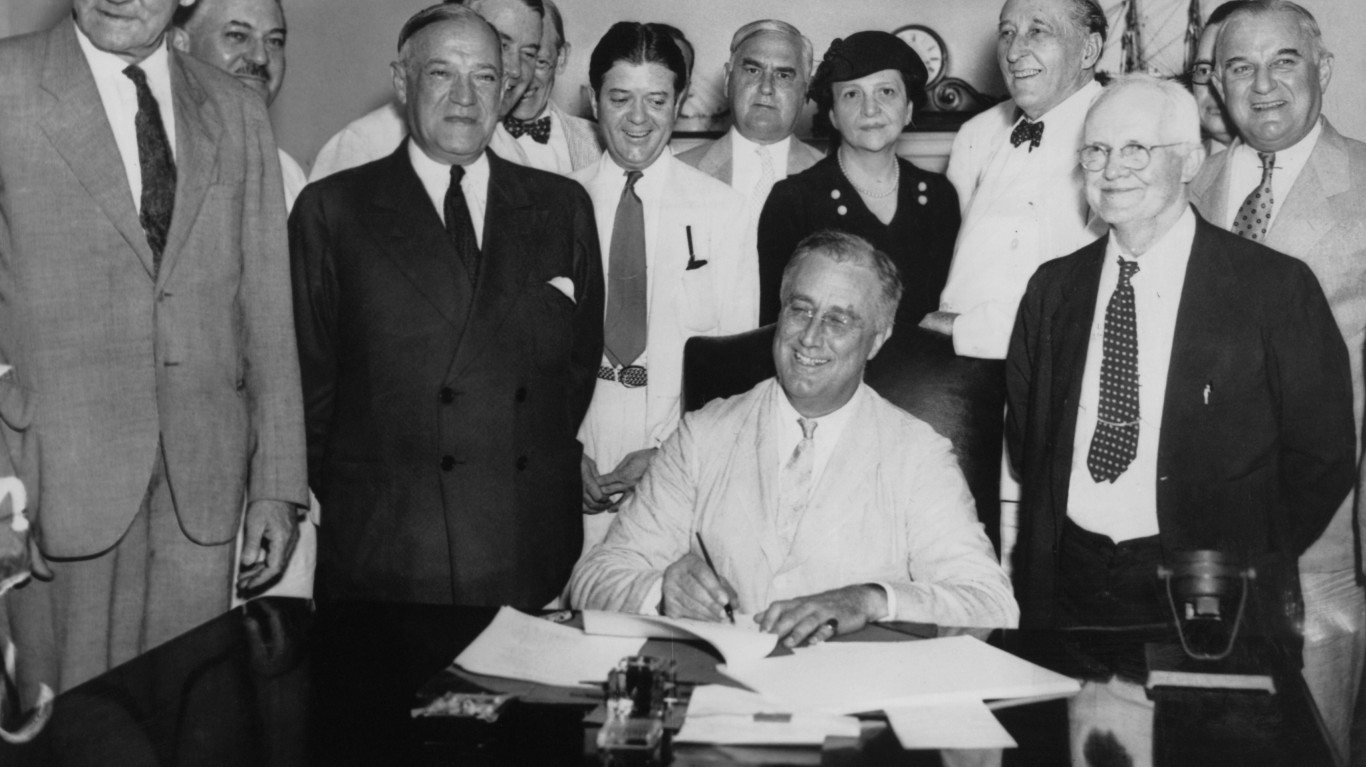
Although we all hate seeing the money come out of our checks on payday, Social Security acts as a safety net for many Americans whether they be retired, disabled, or the survivors of the insured. The program has been around for almost 90 years, yet a lot of Americans don’t know much about it or how it actually functions beyond how it affects the bottom line on their paychecks.
When the Social Security Administration began, it covered workers in just over half of jobs within the United States. Today, coverage is nearly universal. The old phrase, “saving money for a rainy day” comes to mind when considering how the SSA functions. Americans pay into the program out of their salaries and this money accrues over time. Later, when they retire – or become injured or disabled – they are able to reap the benefits of the program. (Here are 10 tips to get the most out of your Social Security income.)
The SSA operates as the largest government program in the United States numerically speaking, and this fiscal year (2022) the agency expects to pay out a whopping $1.2 trillion in benefits to some 66 million individuals. For comparison, the fiscal 2022 national defense budget came in at $777.7 billion.
While some people supplement their retirement savings through annuities, 401ks, or IRAs, many rely on Social Security, or at least in part, so the more beneficiaries – or potential beneficiaries – know about the program, the better. (See what it costs to retire comfortably in every state.)
Click here to see 10 things most people don’t know about social security.

1. “Social Security” is officially the The Old-Age, Survivors, and Disability Insurance program
The OASDI program provides monthly benefits to qualified retired and disabled workers and their dependents and to survivors of insured workers. Eligibility and benefit amounts are determined by the worker’s contributions to Social Security over the course of employment. There is no means test to qualify for benefits, although there is a limit on additional income earned from working while collecting Social Security that applies to those under the full retirement age.
[in-text-ad]

2. The first Social Security Act was passed in 1935
The Social Security Administration was created in 1935 as the “Social Security Board,” assuming its present name in 1946. The preamble to the Social Security Act of 1935 describes it as “An act to provide for the general welfare by establishing a system of Federal old-age benefits, and by enabling the several States to make more adequate provision for aged persons, blind persons, dependent and crippled children, maternal and child welfare, public health, and the administration of their unemployment compensation laws; to establish a Social Security Board; to raise revenue; and for other purposes”

3. The Social Security Act makes provisions for helping the blind
In both the preamble cited above and Title X of the Social Security Act of 1935, the blind are specifically included. As of 2022, there are currently 12 million Americans aged 40 and above suffering from vision impairment, and roughly a million of those are blind. If a worker’s earnings were lower for certain years because of blindness, those years can be excluded from Social Security calculations, and the amount of benefits the blind are eligible for will increase.

4. New data shows that Social Security could start running out of money after 2034
Each year the Trustees of the Social Security and Medicare trust funds report on the current and projected financial status of each program. As it stands now, Social Security and Medicare both face long-term financing shortfalls under currently scheduled benefits and financing. Costs of both programs will grow faster than gross domestic product (GDP) through the mid-2030s primarily due to the rapid aging of the U.S. population.
The assumptions in the most recent Trustees’ report were determined in mid-February 2022, and developments since then have added to the uncertainty regarding the path of the COVID-19 pandemic and the economy in the near term. As a result, the Trustees project that the Social Security trust fund will be able to pay scheduled benefits on a timely basis only until 2034 (one year later than reported last year). At that time, the fund’s reserves will become depleted, and continuing tax income will be sufficient to pay only 77% of scheduled benefits.
[in-text-ad-2]

5. The financial benefits from Social Security stop rising if people take them after age 70
According to the SSA, individuals can start receiving Social Security retirement benefits as early as age 62. However, individuals are entitled to full benefits when they reach their full retirement age. If there is a delay in taking benefits from the full retirement age up to age 70, the benefit amount will increase. Also, if individuals start receiving benefits early, these benefits are reduced a small percentage for each month before the full retirement age.

6. Social Security has agreements with several other countries so benefits are not double-taxed
In the late 1970’s, the United States established a network of bilateral Social Security agreements that coordinate the U.S. Social Security program with the comparable programs of other countries. These International Social Security agreements, often called “totalization agreements,” have two main purposes. First, they eliminate dual Social Security taxation, the situation that occurs when a worker from one country works in another country and is required to pay Social Security taxes to both countries on the same earnings. Second, the agreements help fill gaps in benefit protection for workers who have divided their careers between the United States and another country. These agreements to coordinate Social Security protection across national boundaries have been common in Western Europe for decades.
[in-text-ad]

7. In 1935, 86% of the members of the House of Representatives voted to approve the Social Security Act
The Ways & Means Committee Report on the Social Security Act was introduced in the House on April 4, 1935, and debate began on April 11th. After several days of debate, the bill was passed in the House on April 19, 1935 by a vote of 372 yeas, 33 nays, 2 present, and 25 not voting. The bill was reported out by the Senate Finance Committee on May 13, 1935 and introduced in the Senate on June 12th. The debate there lasted until June 19th, when the Social Security Act was passed by a vote of 77 yeas, 6 nays, and 12 not voting.

8. Almost 70 million people receive Social Security benefits
In 2020, the most recent year for which data is available, 69.8 million people received benefits from programs administered by the SSA. That same year, 5.8 million people were newly awarded Social Security benefits. Also, 55% of adult Social Security beneficiaries in 2020 were women.

9. There’s no Social Security tax on annual wages over $147,000
The OASDI program limits the amount of earnings subject to taxation for a given year. The same annual limit also applies when those earnings are used in a benefit computation. This limit changes each year as the national average wage index rises or falls. The SSA calls this annual limit the contribution and benefit base, also commonly referred to as the taxable maximum. For earnings in 2022, this base is $147,000.
[in-text-ad-2]

10. The Social Security Administration is one of the largest federal agencies
As of 2018, about 60,000 people were employed by SSA. The agency offers its services to the public through 1,200 field offices, a website, and a national toll-free number. Note that these field offices served 43 million individuals in 2019. In addition the agency also includes 10 regional offices, 8 processing centers, and 37 teleservice centers.
100 Million Americans Are Missing This Crucial Retirement Tool
The thought of burdening your family with a financial disaster is most Americans’ nightmare. However, recent studies show that over 100 million Americans still don’t have proper life insurance in the event they pass away.
Life insurance can bring peace of mind – ensuring your loved ones are safeguarded against unforeseen expenses and debts. With premiums often lower than expected and a variety of plans tailored to different life stages and health conditions, securing a policy is more accessible than ever.
A quick, no-obligation quote can provide valuable insight into what’s available and what might best suit your family’s needs. Life insurance is a simple step you can take today to help secure peace of mind for your loved ones tomorrow.
Click here to learn how to get a quote in just a few minutes.
Thank you for reading! Have some feedback for us?
Contact the 24/7 Wall St. editorial team.
 24/7 Wall St.
24/7 Wall St.